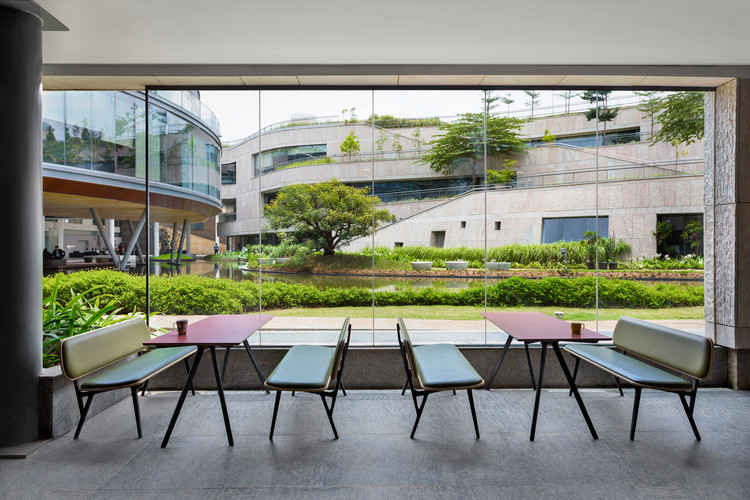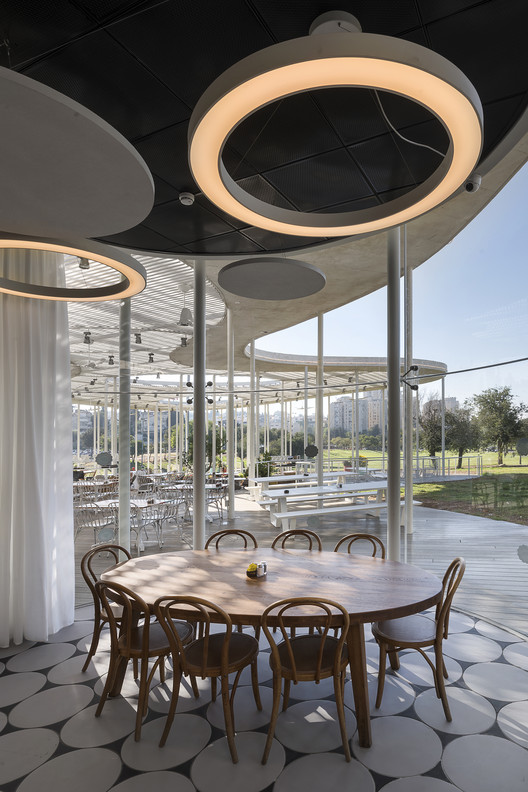AD Classics The Dymaxion House Buckminster Fuller
2013-07-12 01:00
1920年,富勒希望建造一个可持续的、自主的、独立的家庭住宅,这是未来的生活机器。尽管从来没有建造过,但Dymaxion的设计在预制和可持续性方面显示出了前瞻性和有影响力的创新。这座房子不仅在自给自足方面堪称典范,而且还可以大规模生产、包装平整并运往世界各地。
In 1920 Fuller wished to build a sustainable autonomous single family dwelling, the living machine of the future. Although never built, the Dymaxion's design displayed forward-thinking and influential innovations in prefabrication and sustainability. Not only would the house have been exemplary in its self-sufficiency, but it also could have been mass-produced, flat-packaged and shipped throughout the world.
More on this revolutionary design after the break...
© The Estate of R. Buckminster Fuller, via rhonalpes-tourism.com
(C)R.Buckminster Fuller的产业,通过rhonalpes-tracism.com
这座100平方米的六角形房屋是一种抗震和抗风暴的结构,由一根中心杆支撑,从那里悬吊缆索,使外墙不受影响。富勒通过将所有永久公用设施集中在中央极,并让其余的内部空间保持模块化,创造了一个灵活的计划,允许租户根据他们的需要改造空间。该设计还展示了屋顶上的风力涡轮机和一个广泛的蓄水池系统来收集和回收水。对于洗澡单位,Fuller申请了“Dymaxion浴室”的专利-一种只需要一杯热水的淋浴,以及一个根本不消耗水的厕所。
The 100 sqm hexagonal house was an earthquake and storm resistant structure, supported by a central pole from which cables would be suspended, allowing the outer walls to be non-bearing. By grouping all permanent utilities in the central pole, and letting the rest of the interior space remain modular, Fuller created a flexible plan that would allow tenants to transform the space according to their needs. The design also shows wind turbines on the roof and an extensive system of cisterns to collect and recycle water. For the bathing unit Fuller patented the “Dymaxion Bathroom” - a shower that required only one cup of hot water, and a toilet that consumed no water at all.
由于这种材料强度大、重量轻、维护最少,所以这座房子是用铝建造的;正如富勒所解释的:
The house was to be constructed from aluminum due to the material's great strength, low weight, and minimum maintenance; as Fuller explained:
“这是Dymaxion原理,在每个给定的功能性能级别上,以越来越少的重量、时间和ERG来做更多的事情。由于所有金属的平均回收率为22年,而且每磅的性能在设计上也有了类似的改善,因此,采用同样的旧材料服务的人越来越多,这意味着越来越多的人得到了更高的标准“[1]。
“that is the Dymaxion principle of doing ever more with ever less weight, time, and ergs per each given level of functional performance. With an average recycling rate for all metals of 22 years, and with comparable design improvements in performance per pound, ephemeralization means that ever more people are being served at ever higher standards with the same old materials” [1]
Dymaxion一直被Fuller抛弃,直到1944年,战后的住房短缺促使富勒重新考虑他以前关于大规模生产住宅单位的想法。为了使这座房子成为现实,富勒很快与比奇飞机工业签订了为期两年的研究合同,后者在第二次世界大战后拥有大量的铝。1946年,富勒完成了两种原型:巴利斯原型和丹伯里原型,尽管它们既没有组装,也没有大规模生产,主要原因是富勒不愿妥协。
The Dymaxion was abandoned by Fuller until 1944, when the post-War housing shortage urged Fuller to revisit his previous idea of mass production of residential units. To make the house a reality, Fuller soon signed a two year research contract with Beech Aircraft industries, who held an abundance of aluminum in the aftermath of World War II. In 1946 Fuller completed two prototypes: the Barwise prototype and the Danbury prototype, though neither were assembled nor mass produced, mainly due to Fuller’s unwillingness to compromise.
© The Estate of R. Buckminster Fuller, via myipamm.net
C.R.Buckminster Fuller的遗产,通过myipamm.net
1948年,该项目的前投资者威廉·格雷厄姆(William Graham)购买并合并了这两种原型,并创建了“威奇托豪斯”(Wichita House),这座房子对最初的Dymaxion有着一种精致的设想:六边形被改造成一个光滑的圆圈,而这栋建筑只在离地面几英寸的地方设置(而不是像Dymaxion那样完全悬挂)。除了获得专利的Dymaxion浴室外,Wichita楼中没有包括任何原始的住房元素。
In 1948 William Graham, a former investor in the project, purchased and combined both prototypes and created the “Wichita House,” which carried a refined vision of the original Dymaxion: the hexagon was transformed into a smooth circle, and the building was set only a few inches above the ground (rather than fully suspended, as the Dymaxion would have been). Aside from the patented Dymaxion bathroom, none of the original housing elements were included in the Wichita House.
Bucky and the Dymaxion © Bettmann/Corbis via britannica.com
Bucky和Dymaxion(Bettmann/Corbis)通过britannica.com
如果能充分发挥其潜力,Dymaxion房屋可能会过早地被遗弃,如果能充分发挥它的潜力,就能解决战后住房短缺的问题,因为它采用了新材料,采用了可持续的技术,而且易于组装和大规模生产。1946年4月,“财富”杂志提出:“‘住宅机器’可能会产生比汽车更大的社会影响”。不幸的是,Dymaxion永远不会得到这样的机会。然而,巴克敏斯特·富勒的可持续性原则和他的“多而少”的哲学在今天的可持续设计领域仍然具有巨大的影响力。
Probably prematurely abandoned, the Dymaxion house could have been a great success if brought to its full potential, providing solutions for the post-war shortage of housing due to its incorporation of new materials, implementation of sustainable technologies, and its ease of assembly and mass-production. In April 1946, Fortune magazine suggested that: “the ‘dwelling machine’ was likely to produce greater social consequences than the introduction of the automobile”. Unfortunately, the Dymaxion, would never be given that chance. However, Buckminster Fuller’s principles of sustainability and his “more with less” philosophy continue to be vastly influential in the field of sustainable design today.
[1]R.Buckminster Fuller:协同学,思维几何学中的探索
[1] R. Buckminster fuller: Synergetics, Explorations in the Geometry of Thinking
建筑师巴克明斯特富勒建筑面积100.0平方米工程年1927年
Architects Buckminster Fuller Area 100.0 sqm Project Year 1927
 举报
举报
别默默的看了,快登录帮我评论一下吧!:)
注册
登录
更多评论
相关文章
-

描边风设计中,最容易犯的8种问题分析
2018年走过了四分之一,LOGO设计趋势也清晰了LOGO设计
-

描边风设计中,最容易犯的8种问题分析
2018年走过了四分之一,LOGO设计趋势也清晰了LOGO设计
-

描边风设计中,最容易犯的8种问题分析
2018年走过了四分之一,LOGO设计趋势也清晰了LOGO设计
















.jpg)

.jpg)



















































